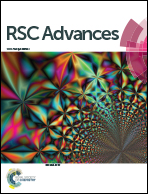Growth of hexagonal phase sodium rare earth tetrafluorides induced by heterogeneous cubic phase core†
Abstract
A heterogenous core/shell strategy has been introduced to induce the growth of hexagonal phase NaREF4 shells. During the core-mediated hetero-shell growth process, the cores significantly affect the crystalline phase of shells. Using heterogeneous cubic nanocrystals as cores, the resulting sub-30 nm hybrid nanoparticles possessed both hexagonal phase shells and good water solubility.


 Please wait while we load your content...
Please wait while we load your content...